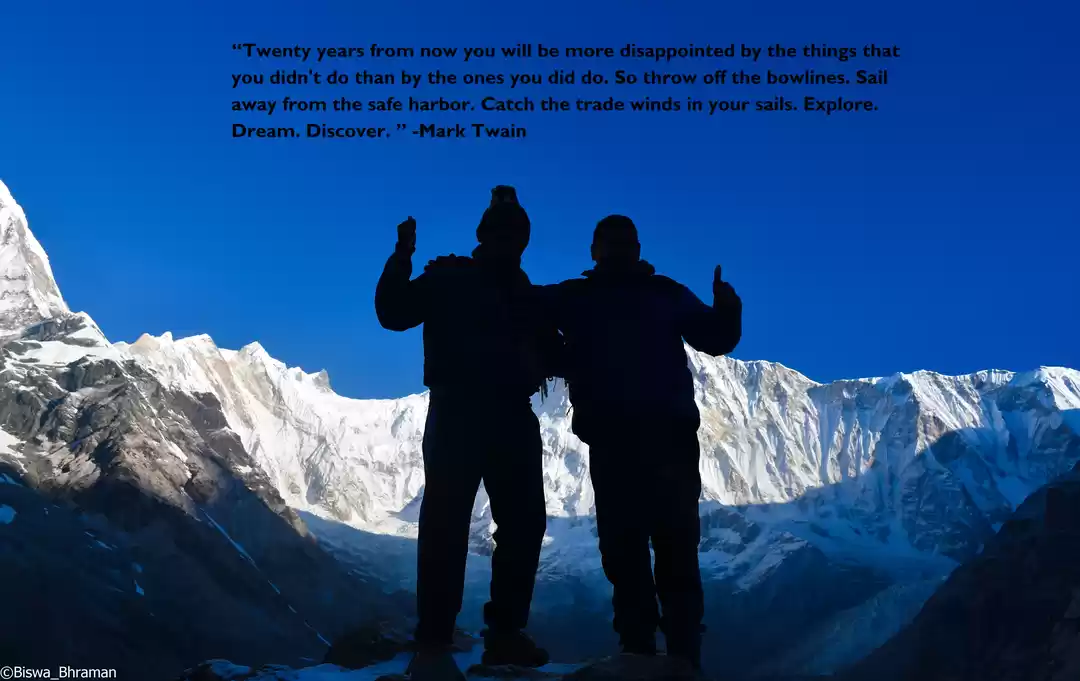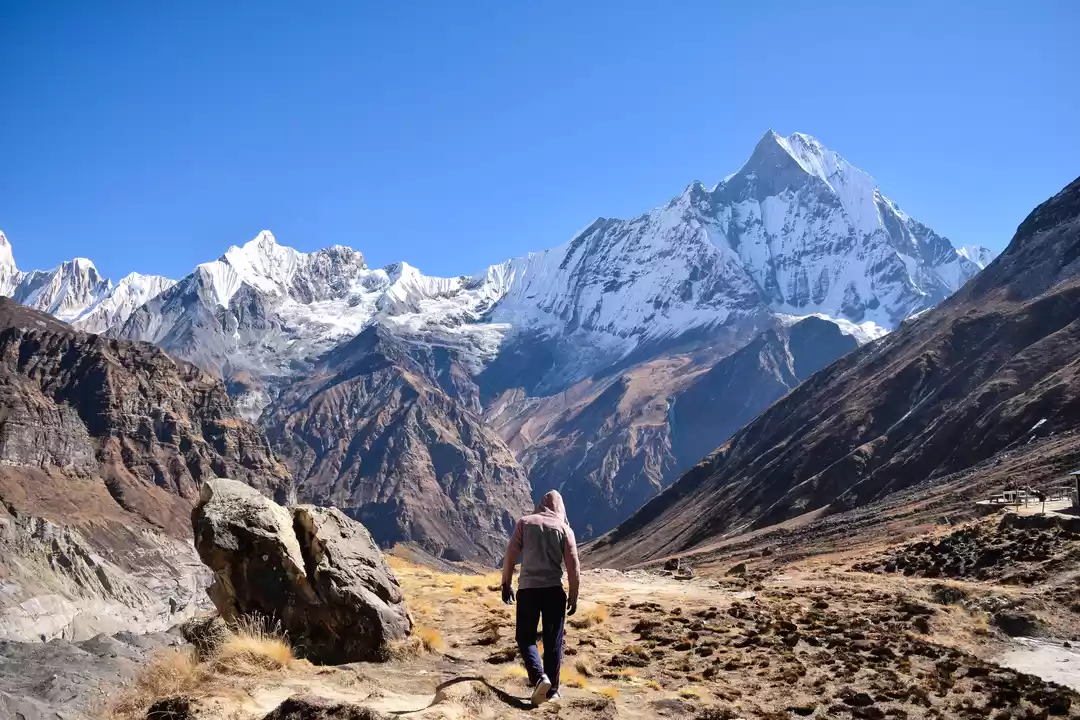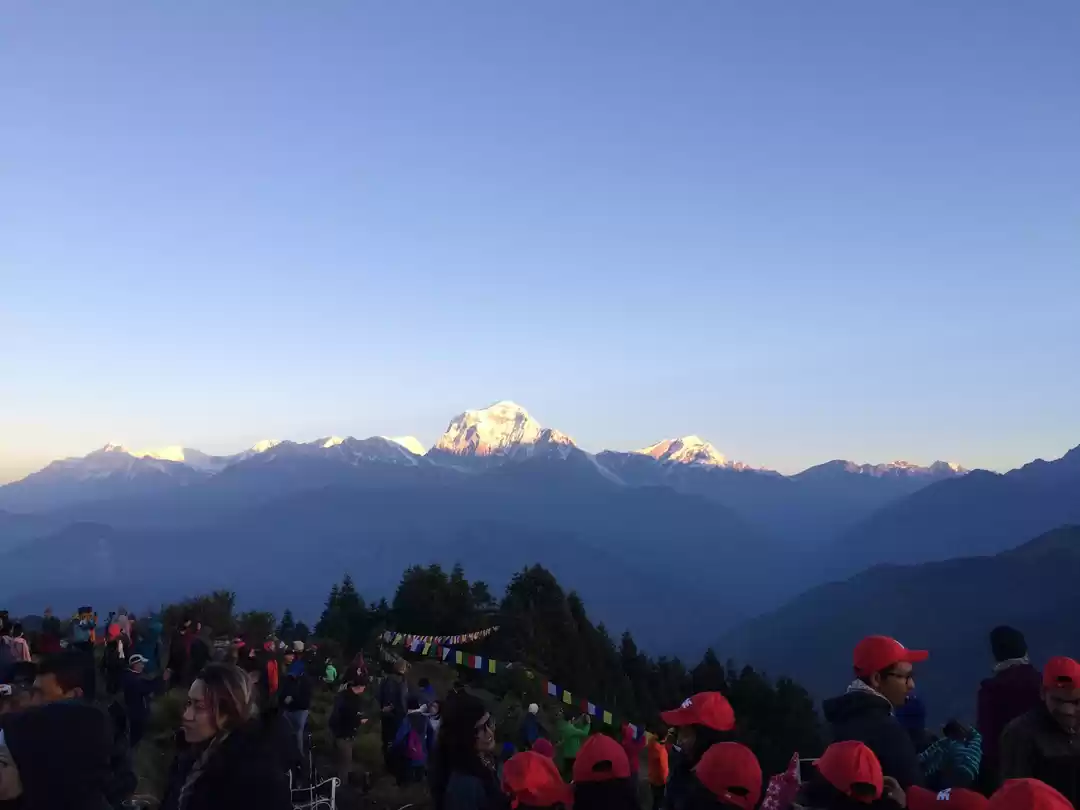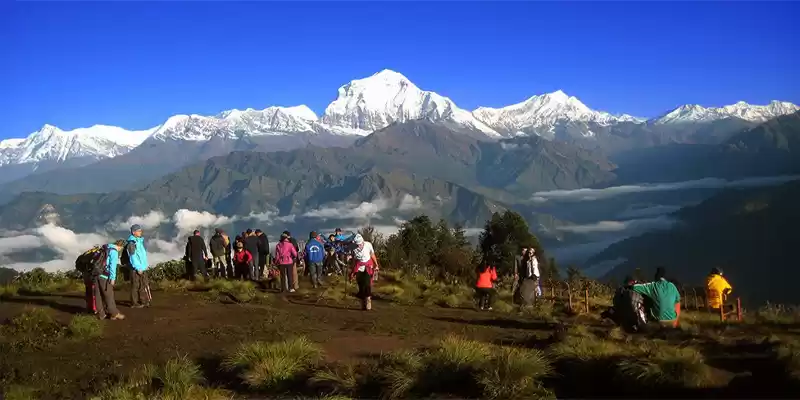
Trekking in Nepal has been a tough decision for me. I have avoided it for a long time as India has so many treks. Finally, after 19 treks in India, I chose to do the ABC trek as my 20th trek.
Selecting the variant of the ABC trek from the multiple choices was a tricky decision, but I finally chose the Ghorepani, Tadapani route rather than the shorter Ghandruk route. I planned to do it solo even if others weren't willing to come, but luckily 2 friends chose to join, Sahit and Ramachandran (who is 70 but has the fitness of a 50-year-old).
I had chosen a mid-April date to avoid the summer showers and we flew into Kathmandu, a very basic airport, where it took 45 minutes for our luggage to come up on the belt. Our guide, Chandra from Mission Eco Treks picked us up from the airport in a Hiace van and drove us to our hotel in Thamel.
A few things about staying in Kathmandu, arrangements on the trek and things to carry
1. Thamel is where all trekkers stay. Strongly suggest staying at the Kathmandu Guest House, even if you need to pay a little extra, it's worth it. We stayed at Hotel Simal, which wasn't bad either, except that KGH is better located and has a big history.
2. You can buy many of your trek accessories in Thamel, which is full of Chinese imports and local fakes. Don't buy shoes for one. However, things like trekking trousers, quick dry Ts, crampons, poles, etc are plenty, decent quality and cheap.
3. You don't have to bring a backpack. Your tour operator will provide you a waterproof bag that is designed for the guide to carry comfortably. You can leave behind things you don't need for the trek.
4. As of this year, it's mandatory for all trekkers to hire a local guide. If you aren't interested in carrying your own stuff, hire a porter, who typically carries bags of two trekkers. Keep it light though.
5. Change your currency to local ones (INR can't be converted, though many outlets may accept it and most Indian debit cards don't work in the ATMs). Carry local currency of 1000 Nepali / day you plan to travel. Your tour operator will cover stay at hotels in the cities (in our case Kathmandu & Pokhara), tea house rent, breakfast, lunch and dinner. You have to pay for coffee/tea/bottled water and wifi. Remember that hot water is expensive and costs at least 150 Nepali / ltr
6. Invest in a water filter like Lifestraw and be worry free of the water quality or buy purification tablets and put up with the aftertaste. Kindly avoid bottled water as waste disposal is a huge challenge in these mountains.
7. Tea houses on the ABC trail are generally pretty good. It is difficult to find tea houses with attached bathrooms from Chomping and beyond. Even in Ghorepani, the best rooms (with great views) have common washrooms. Having said that I found all tea houses to be very clean, provide good bedding and blankets. The bathrooms in all the tea houses were well maintained (though at MBC there was no water as the pipes froze). If you are very particular, do carry a sleeping bag liner.
8. If the weather is fine, you can wash your clothes, all tea houses have cloth drying lines, but do consider carrying cloth clips.
9. Once the trek starts, the menu is identical in all the tea houses, though food does taste different (and is prepared differently in each of them). The most common is the Nepali staple Dal Bhat; rice with lentil soup (dal for us Indians), seasonal veggies, greens and chutneys. You can also order rice with curry (both veg and chicken), eggs prepared to your taste, fried rice, noodles, pasta, momo's etc. At some places like Ghorepani, you can order steak as well.
10. Beer is sold in every store and is available at all tea houses. The most common advertisement board in Nepal seems to be Tuborg! Avoid drinking as you climb up and have your celebration as you come down to avoid dehydration.
Now let me get to the trek description
Day -1: Arrive in Kathmandu and explore Thamel. Make all last-minute purchases and convert dollars/Euro to local currency
Day 0: Travel to Pokhara. We chose to travel by private Hiace, a much better option than public buses. Kathmandu Pokhara highway is a construction site and the entire 200-odd kilometre is being made 4 to 6 lanes at the same time. As a result the 200kms is a bone-jarring and dust-filled 8 to 9 hr journey that completely exhausts you. Every structure and plant is coated with dust the entire journey (except for a 30 km stretch, which will soon be taken up for road widening). The dust is so much that you can't see the other side of the valley. Locals believe that it will take another 4 years for the road to be ready. The practical way is to fly to Pokhara (which depends on the weather).
We stayed next to the lake area in Pokhara and the place is absolutely beautiful. The area has clean roads and pedestrian walkways, lined up with restaurants and shops that sell all accessories to trekkers.
Day 1: Pokhara to Nayapul and trek to Ulleri
Our big day finally arrived and we started in a 4x4 with Chandra and 2 porters (Guru and Sajan) to Nayapul. There is a short stretch of bad road, which is otherwise pretty smooth till Nayapul.
From here starts the trek, initially along the road till Birethanti, in the company of Modi Khola (river in local lingo). At Birethanti, we leave the road and start on a jeep trail along the Bhurungdi river, a trail on which an occasional bus or 4x4 crosses you. Plenty of neat tea house dot the trail and we did stop at a couple of them. On this stretch the sun is beating down and you are well served by caps and sunscreen as well as plenty of water.
Sahit discovered the danger of wearing too much of warm clothing as he was struggling with exhaustion. Once he removed the warm layers and started walking in just a t shirt, he was fine and that was the code to be followed for the rest of the trek till we were close to MBC.
By mid-day we reached Thikedunga where we had lunch. The wifi at the tea house enabled us to call our families. From Thikedunga, it's a brutal climb to Ulleri, some 5000 stone steps to climb a little over 500m in altitude. The accommodation we had in Ulleri was very basic and our guide agreed to check us into better places from the next point onwards. The food though was excellent.
Day 2: Ulleri to Ghorepani
This is a day where we're trekking through forests. On the trail we met a lot of people, a large group from Singapore, Australians, Finns, Germans and an old American couple in their 70s. They inspired us gave us goals for old age fitness.
Ramachandran went ahead and soon we lost him. We got worried that he had taken a wrong trail and waited at one of the tea shops, while our guide went back on the trail. Soon we got a message from a group which went ahead that Ramachandran was well ahead of us! I let Chandra accompany Sahit and raced behind him and it still took me a good 40 minutes to catch up with him. The oldest in the group was setting the pace!
Just before Ghorepani, they once again check your TIMS card after which we went to the tea house aptly named Hill Top Hotel. This place is known to offer great views of Dhaulagiri and Annapoorna ranges, but alas due to the haze, we couldn't even see the hills across the valley! This year (2023) rains have been scanty during March in Nepal, leading to forest fires and thick haze. It was in Ghorepani we got news that it was snowing in ABC.
Hill Top hotel is pretty popular and crowded and we met numerous group of trekkers, including several solo trekkers who had completed the circuit.
Day 3: Ghorepani - Poonhill and back and then to Chuile
The Poonhill trek is a highlight of the Ghorepani visit, from where you can see the Annapoorna, Machapuchare and Dhaulagiri lit up golden by the sunrise. But our guide stated that with prevailing haze, there was no guarantee of the view and hence Ramachandran and Sahit, chose to skip the 4:30 wakeup call and hike in the freezing cold.
I however decided to do the trek, got up at 4:30 and reached the top in a little over 40 minutes, guided by a head torch in the early morning darkness. The hardship was decently rewarded as I managed to catch Dhaulagiri and Annapurna south. The haze though, did play spoil sport.
Once we got back we finished and started on what would be a very long and tough day (14 kms including the 3k Poonhill trek). We would realise 3 days later that our guide had made a serious mistake that would make the trek arduous but also resulted in an unlikely pleasant surprise. Our guide had by mistake assumed that we had to finish the trek in 9 days rather than 10 days. hence he decided to extend the day till Chuile rather than Tadapani, where we were originally scheduled to stop for the day.
From Ghorepani the trail is upwards, a climb of 300m before it flattens into a ridge walk till you cross the Deurali pass (not the one near MBC). From here it's an easy walk till Banthanti, where everyone breaks for lunch. From Banthanti the trek gets tough, initially it's a descent of about 300m from Banthanti and then a climb of 250m to reach Tadapani. The long up and down is pretty taxing considering that the trail is anything but scenic.
The trail is not supposed to be so dull. This trail is full of rhododendron and usually, April is filled with blooms making the valley spectacular. The dry March has affected the blooms and very few of the trees had bloomed, resulting in a dull trail.
Once we reached Tadapani, it began to get cloudy and we started the descent to Chuile, a drop of 600m in altitude. Chuile has views of Khimrong river and you can also see Jhinu danda from here. It had the best tea house of our entire trip that even offered a washing machine to wash our clothing. This is the last place where you will get a room with an attached bath, till you get to Jhinu Danda.
Day 4: Chuile to Upper Sinuwa
Today would be another brutal day of up and down climbs. The trek began with a sharp drop of 200m to the river and across a cable stay bridge. From the valley, it's a steady climb through the day, 1900m to 2800m to reach Chomrong. The trail though is pretty safe, but the haze made it a boring climb as there is nothing to photograph.
Closer to Chomrong, the weather cools down significantly, we are now very close the glaciers. We stopped for lunch at probably the highest point in Chomrong, a thoroughly enjoyable bowl of vegetable curry with rice. From here it was another descent, the toughest of the trek. We have to climb down close to 6000 steps, from 2800m to 1900m and left us with aching knees.
The day didn't end though, from the bottom it was a 700m climb to upper Sinuwa. The day was by far the toughest for us.
The lodge at upper Sinuwa was basic but clean and offered excellent food. It began raining in the evening and would continue through the night intermittently
Day 5: Upper Sinuwa to Bamboo
We had made our first adjustment to the schedule. Overnight we decided that we will not camp at ABC, but at MBC and make a trip to ABC from there. Hence, we decided to reach out till Himalaya on day 5, 300m below Derail, the original plan.
However, as the day broke, we were greeted with pouring rain. Once we finished breakfast, all the trekkers were waiting for rain to abate, which happened only by 8:45 am, a delay of more than an hour.
We set out on our trail in a mild drizzle, which meant no photographs. The trail is a gentle descent into Bamboo, before it again becomes a climb through, you guessed it, bamboo forest. The path comes out of forest and you enter Dovan and later upper Dovan. From Dovan it's a steady climb to Himalaya.
En route to Himalaya, you have a beautiful waterfall as well as a temple at which both Hindus and Buddhist pray. Another steep climb and Himalaya village comes into view. From here, we could clearly catch a glimpse of snow capped mountains, though Machapuchare remained behind clouds.
Day 6: Himalaya to Machapuchare base camp
After the previous day rains, the day dawned very clear and bright. We left after a quick breakfast and were exited to see frozen puddles of water and icicles handing from the rock.
At Hinku cave, icicles were falling down from the rocks. We could also begin to see Machapuchare and Deurali pass.
At Deurali, it was pretty cold and you could observe snow around the trail. As we walked ahead the snow was more common and we had some snow fight as well. we were now gaining height as well as walking on path lined with snow.
Back at Kathmandu, they told us that there is no snow and no crampons were needed. We still went ahead and bought micro crampons. It was now time for the crampons as were walking in snow. However a mere 200m walk showed us that the micro crampons were useless. These local ones were poorly designed and ice was accumulating between the shoes and the crampons. Rather than help us the crampons became useless. By now it also started snowing. we discarded the crampons and started walking on the snow, which was assuming blizzard like proportions. As we neared MBC, the snow was so heavy that visibility was less than 50m.
Both of my colleagues were trekking in snow for the first time and were having considerable difficulty. Luckily, no one slipped in the snow and we reached the MBC tea house (Shankar lodge). Snow was accumulating all around and it had piled up more than 3/4th up the windows in the room.
Lunch time was a serious discussion. It was a blizzard out and the team was concerned about the trek to ABC without crampons and gaiters. It was predicted that the snow would again start by 11 am the next morning, which meant that the option was to go to ABC and be back at MBC by 11 am. Finally, the team decided to drop ABC and head back the next day.
It was at this point that we discovered the mistake by our guide with the schedule. We suddenly found ourselves with an extra day! It was the call of the lord, Muktinath trip which was dropped because we couldn't make the trip within our schedule was suddenly feasible and we immediately asked our tour operator to organise a vehicle to pick us up from Jhinu Danda and take us to Muktinath.
It continued snowing till late evening and we spent the coldest night, I think about -6 deg C, in a pretty comfortable room.
Day 7: MBC to Bamboo.
The morning was clear sky but a completely white fairy land. Stepping out we could see Machapuchare on the east, Himchuli, Annapurna 1 & south and fang to the west and Annapurna 2 & Gangapurna to the north.
The clear weather was to change by 11 am and we started our careful descent in snow. It was clear that it had snowed heavily after we had reach the camp the previous day as the level of snow was much higher. The previous day, we had heard from another trekker that they saw an avalanche just ahead of them between MBC & ABC. We also saw a traveller being carried from ABC to MBC as he had developed altitude sickness. An air ambulance was now evacuating hime from MBC. Meanwhile, a number of helicopter trips were being made from Pokhara to ABC ferrying the rich for their breakfast and photo at ABC.
We trudged slowly through the snow and were horrified to see a small avalanche across the valley. Luckily, we were coming down fast and had no risk on our path. Snow had almost reached 3200m now and we crossed the snow line at Deurali.
By this time, the snow started in the higher ranges and we were glad to have escaped it. We wanted to escape the rain further and began our descent with more earnestness. After lunch at Himalaya, we decided to go as low as possible, to lower Dovan or preferably Bamboo. We pushed ourselves and reached Bambo for the night halt.
For once it was going to be significantly warmer in the night. Bamboo offers good photo op of Machapuchare and it was visible in the evening and we were hoping for a clear morning to catch a picture of the sun light making it golden in the morning. Alas it snowed and we heard snow had started even in Deurali.
Day 8: Bamboo to Jhinu Danda
The valley was clear when we woke up, but the peaks were already getting overcast. It was clear that rain would hit the trail sooner than later and we started in a hurry.
After an initial climb to Sinuwa, it would be 800m descent to the Chomrong river bridge followed by a 900m climb to Chomrong and then a final 1000m descent to Jhinu Danda. A tough day of trekking, about to become tougher. The previous day, I discovered my 3 year old trek shoes had lost its water proofing, water was engrossing from the fabric near the toe and my shoes had become damp. I was hoping it wouldn't rain.
The rain held up till we started the Chomrong climb and then it poured the entire afternoon. Post lunch we waited at the tea house for nearly an hour, but the rain was not relenting. We began our walk towards Jhinu in the pouring rain, when news came that it was snowing all the way upto Himalaya. My feet were fully wet and there was puddle of water in inside my shoes now. We were happy to walk into a brand new property in Jhinu that offered very warm beds, hot shower and hot food.
We had our celebrations that night with the knowledge that tough trek was now done
Day 9: Jhinu to Muktinath
We had a 8:30 start. This day involved a 20 minute hike across the longest cable stay bridge I had seen (280m), a hop onto a Mahindra Scorpio, a 2 km hike and then finally getting on board a 4x4 Scorpio. The road to Muktinath has a few good stretches, but most of it is a Moto cross after the first 30 km stretch. On top of it between 1 pm to 4 pm a section of the road is closed for road work.
We had lunch at Tatopani (different from Tadapani on the trail), where there are also hot water springs. Post lunch we had to wait out the road closure, which is when I saw the big enclosure where Khaleej pheasants were being reared along with chicken! Apparently, they are a delicacy in Nepal.
We left at 3:30pm only to find that a big rock was in the middle of the road. It took another hour to remove and we had lost 90 minutes in the traffic jam.
As they say all such incidents have a silver lining and we found it when we reached the flats of Kalapani by 5:45 pm. It was sunset time and we had some spectacular views of Annapurna, Neelgiri and Dhaulagiri.
After this, it was a drive through darkness in poor roads past Jomsom to Muktinath, which we reached close to 9 pm. Muktinath was freezing and the night was heading towards -7 deg C. But the hotel was very good, two layers of comforters meant that we had a very good sleep
Day 10: Muktinath to Pokhara
We got up to great views of Dhaulagiri. After a hot shower, we headed to Muktinath temple, a very spiritual place with amazing energy.
Post breakfast (and after lot of pictures) we headed back on the long journey to Pokhara (this time before the road closure)
Day 11: Pokhara to Kathmandu
Day 12: Kathmandu sight seeing
So that's all folks on our exciting trip and hope you all enjoyed my narrative.
You can find my travel adventures in my book For the Love of Mountains, a coffee table book I published during the pandemic and available here: https://notionpress.com/read/for-the-love-of-mountains-1338873
With love
Krishnan

























